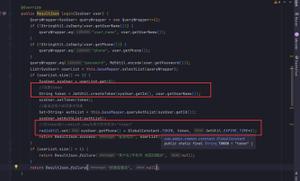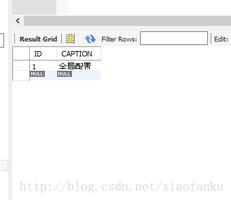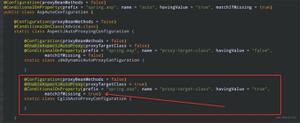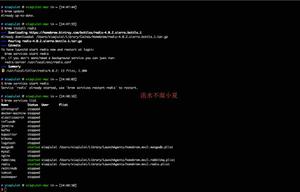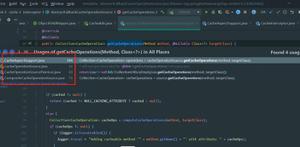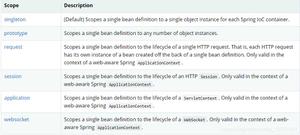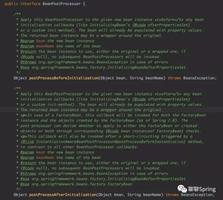Spring Bean的作用域(转)
本文内容纲要:Spring Bean的作用域(转)
Spring Bean的作用域
.singleton [单例] eg:
在每个Spring IoC容器中一个bean定义只有一个对象实例。
请注意Spring的singleton bean概念与“四人帮”(GoF)模式一书中定义的Singleton模式是完全不同的。
经典的GoF Singleton模式中所谓的对象范围是指在每一个ClassLoader中指定class创建的实例有且仅有一个。
把Spring的singleton作用域描述成一个container对应一个bean实例最为贴切。亦即,假如在单个Spring容器内定义了某个指定class的bean,
那么Spring容器将会创建一个且仅有一个由该bean定义指定的类实例。
org.springframework.beans.factory.config.ConfigurableBeanFactory
/** * Configuration interface to be implemented by most bean factories. Provides
* facilities to configure a bean factory, in addition to the bean factory
* client methods in the {@link org.springframework.beans.factory.BeanFactory}
* interface.
*
* <p>This bean factory interface is not meant to be used in normal application
* code: Stick to {@link org.springframework.beans.factory.BeanFactory} or
* {@link org.springframework.beans.factory.ListableBeanFactory} for typical
* needs. This extended interface is just meant to allow for framework-internal
* plug'n'play and for special access to bean factory configuration methods.
*
* @author Juergen Hoeller
* @since 03.11.2003
* @see org.springframework.beans.factory.BeanFactory
* @see org.springframework.beans.factory.ListableBeanFactory
* @see ConfigurableListableBeanFactory
*/
public interface ConfigurableBeanFactory extends HierarchicalBeanFactory, SingletonBeanRegistry {
/**
* Scope identifier for the standard singleton scope: "singleton".
* Custom scopes can be added via {@code registerScope}.
* @see #registerScope
*/
String SCOPE_SINGLETON = "singleton";
/**
* Scope identifier for the standard prototype scope: "prototype".
* Custom scopes can be added via {@code registerScope}.
* @see #registerScope
*/
String SCOPE_PROTOTYPE = "prototype";
默认情况下会在容器启动时初始化bean,但我们可以指定Bean节点的lazy-init=“true”来延迟初始化bean,这时候,只有第一次获取bean会才初始化bean。
如:
如果想对所有bean都应用延迟初始化,可以在根节点beans设置default-lazy-init=“true“,如下:
<beans default-lazy-init="true“ ...>
.prototype [原型]
每次从容器获取bean都是新的对象。
对于prototype作用域的bean,有一点非常重要,那就是Spring不能对一个prototype bean的整个生命周期负责:容器在初始化、配置、装饰或者是
装配完一个prototype实例后,将它交给客户端,随后就对该prototype实例不闻不问了。不管何种作用域,容器都会调用所有对象的初始化生命周期回调方法。
但对prototype而言,任何配置好的析构生命周期回调方法都将不会被调用。清除prototype作用域的对象并释放任何prototype bean所持有的昂贵资源,
都是客户端代码的职责。(让Spring容器释放被prototype作用域bean占用资源的一种可行方式是,通过使用bean的后置处理器,该处理器持有要被清除的bean的引用。)
以下的三种scope只是在web应用中才可以使用
.request
.session
.global session
使用这三种配置之前要先初始化Web配置
http://www.cnblogs.com/njtcy/p/3328076.html
/** * When used as a type-level annotation in conjunction with
* {@link org.springframework.stereotype.Component @Component},
* {@code @Scope} indicates the name of a scope to use for instances of
* the annotated type.
*
* <p>When used as a method-level annotation in conjunction with
* {@link Bean @Bean}, {@code @Scope} indicates the name of a scope to use
* for the instance returned from the method.
*
* <p><b>NOTE:</b> {@code @Scope} annotations are only introspected on the
* concrete bean class (for annotated components) or the factory method
* (for {@code @Bean} methods). In contrast to XML bean definitions,
* there is no notion of bean definition inheritance, and inheritance
* hierarchies at the class level are irrelevant for metadata purposes.
*
* <p>In this context, <em>scope</em> means the lifecycle of an instance,
* such as {@code singleton}, {@code prototype}, and so forth. Scopes
* provided out of the box in Spring may be referred to using the
* {@code SCOPE_*} constants available in the {@link ConfigurableBeanFactory}
* and {@code WebApplicationContext} interfaces.
*
* <p>To register additional custom scopes, see
* {@link org.springframework.beans.factory.config.CustomScopeConfigurer
* CustomScopeConfigurer}.
*
* @author Mark Fisher
* @author Chris Beams
* @author Sam Brannen
* @since 2.5
* @see org.springframework.stereotype.Component
* @see org.springframework.context.annotation.Bean
*/
@Target({ElementType.TYPE, ElementType.METHOD})
@Retention(RetentionPolicy.RUNTIME)
@Documented
public @interface Scope {
/**
* Alias for {@link #scopeName}.
* @see #scopeName
*/
@AliasFor("scopeName")
String value() default "";
/**
* Specifies the name of the scope to use for the annotated component/bean.
* <p>Defaults to an empty string ({@code ""}) which implies
* {@link ConfigurableBeanFactory#SCOPE_SINGLETON SCOPE_SINGLETON}.
* @since 4.2
* @see ConfigurableBeanFactory#SCOPE_PROTOTYPE
* @see ConfigurableBeanFactory#SCOPE_SINGLETON
* @see org.springframework.web.context.WebApplicationContext#SCOPE_REQUEST
* @see org.springframework.web.context.WebApplicationContext#SCOPE_SESSION
* @see #value
*/
@AliasFor("value")
String scopeName() default "";
/**
* Specifies whether a component should be configured as a scoped proxy
* and if so, whether the proxy should be interface-based or subclass-based.
* <p>Defaults to {@link ScopedProxyMode#DEFAULT}, which typically indicates
* that no scoped proxy should be created unless a different default
* has been configured at the component-scan instruction level.
* <p>Analogous to {@code <aop:scoped-proxy/>} support in Spring XML.
* @see ScopedProxyMode
*/
ScopedProxyMode proxyMode() default ScopedProxyMode.DEFAULT;
}
本文内容总结:Spring Bean的作用域(转)
原文链接:https://www.cnblogs.com/softidea/p/4439727.html
以上是 Spring Bean的作用域(转) 的全部内容, 来源链接: utcz.com/z/362423.html


